Ultimate Namibia Safari
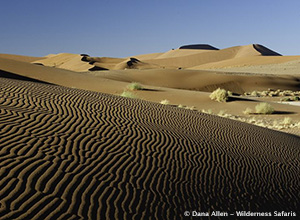
Duration: 10 days
Area: Sossusvlei, Damaraland, Namib Desert, Etosha
Style: True African Safari
Comfort Level:![]()
![]()
![]()
![]()
![]()
This Ultimate Namibia Safari affords you the chance to experience this magnificent and memorable country in a very personal way. You will have your own professional and experienced safari guide who will enhance your enjoyment of this unique country by making it a fascinating and stress-free journey of discovery amidst very dramatic scenery. The knowledge, experience, and character of our guides are critical to a successful safari which is why we ensure that they are both personable and very professional.
Your Ultimate Safaris guide will have an intimate knowledge of each area and camp/lodge that you visit, allowing them to share the local insights and highlights whilst adding continuity and depth to your safari. It goes without saying that they all know exactly what a "True African Safari" is all about. Not only are our guides highly qualified, each has a specific area of expertise. Together they possess the breadth and depth of knowledge to allow them to answer questions and satisfy the particular interests of each of our guests. The presence and company of your Ultimate Safaris guide will turn your safari into an experience of a lifetime!
Highlights:
- Travel with one of Namibia’s most reputable and well-known naturalist guides.
- Stay in the only camp inside the world’s 4th largest National Park.
- Climb some of the world’s highest free-standing sand dunes.
- Sea kayak with seals and dolphins on the Skeleton Coast (option ski boat).
- Track for desert-adapted elephants.
- Visit the UNESCO World Heritage Site at Twyfelfontein.
- Visit remote Himba settlement.
- Explore 2 very different parts of the Etosha National Park by spending time on both the Ongava and Onguma Private Game Reserves.
- Sleep in the tree tops overlooking one of the most productive waterholes on the Onguma Private Game Reserve.
- Visit the world renowned Big Cat research centre run by the AfriCat Foundation.
- Introducing Guide in Training Program for Children. View Details
| Day 1 & 2 | Arrive in Windhoek by 08h00. Set off by road to Sossus Dune Lodge, Sossusvlei Day 3 |
| Day 3 & 4 | Stay at a centrally located guesthouse in Swakopmund. |
| Day 5 & 6 | Stay at Camp Kipwe, Damaraland. |
| Day 7 | Cross to Andersson’s Camp, Southern Etosha National Park. |
| Day 8 & 9 | Game drives to Onguma Tree Top Camp, Eastern Etosha National Park. |
| Day 10 | Okonjima Day Visitor Centre, AfriCat Foundation; return to Windhoek in the late afternoon. |
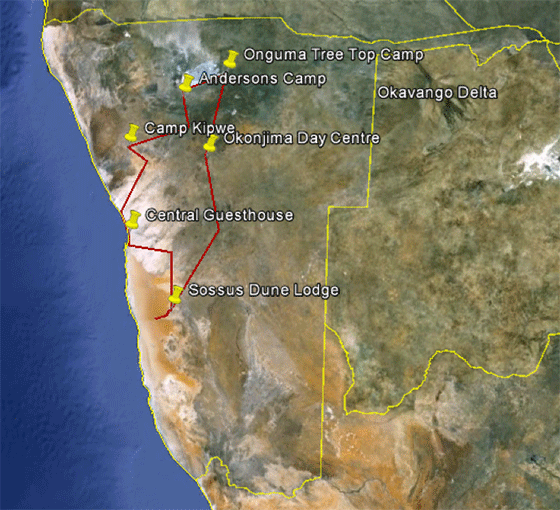
Detailed Itinerary
Day 1: Windhoek to Sossusvlei area
This morning Ultimate Safaris will collect you from your various accommodation establishments or from the Windhoek International Airport (assuming you land before 08h00). You then depart Windhoek in your safari vehicle with your private guide and drive southwest through the scenic Khomas Hochland highlands before heading down the Great Escarpment into the Namib Desert below, stopping for a picnic lunch at a scenic location along the way. You arrive at Sossus Dune Lodge in the midafternoon and you will stay here for two nights whilst you explore the remarkable sights of the Namib Desert with your guide. If there is still time today, your guide will take you to visit Sesriem Canyon, a nearby geological attraction, or explore Elim Dune. However, if you prefer, you can just relax and soak in the scenic and tranquil surroundings at Sossus Dune Lodge.
Sesriem Canyon: Sesriem Canyon has evolved through centuries of erosion by the Tsauchab River which has incised a narrow gorge about 1.5 km long and 30 meters deep into the surrounding conglomerates, exposing the varying layers of sedimentation deposited over millions of years. The shaded cool depths of the canyon allow pools of water to gather during the rainy season and remain for much of the year round. These pools were a vital source of water for early settlers who drew water for their livestock by knotting six (ses) lengths of rawhide thongs (riems) together, hence the canyon and surrounding area became known as Sesriem.
Overnight: Sossus Dune Lodge
Lunch, Dinner & Excursions with Guide
Day 2: Sossusvlei / Namib Desert
This morning you will need to rise early for a magical excursion with your guide in the Namib Naukluft National Park, normally setting off before sunrise to capture the dunes whilst the light is soft and shadows accentuate the towering shapes and curves. This area boasts some of the highest free-standing sand dunes in the world and your guide will give you an insight on the formation of the Namib Desert and its myriad of fascinating creatures and plants that have adapted to survive these harsh environs. Once you have explored Sossusvlei, Deadvlei and surrounding dune fields to your heart’s content you can enjoy a relaxed picnic brunch in the shade of a camel thorn tree. You then return to Sossus Dune Lodge in the early afternoon in time for a late lunch, with the option to visit Sesriem Canyon afterwards if you haven’t already done so the day before. The rest of the afternoon is at your leisure (from experience, this is usually welcomed after an exhilarating morning in the dunes).
Sossusvlei: This most frequently visited section of the massive 50,000 km² Namib Naukluft National Park has become known as Sossusvlei, famous for its towering apricot coloured sand dunes which can be reached by following the Tsauchab River valley. Sossusvlei itself is actually a clay pan set amidst these star shaped dunes which stand up to 300 meters above the surrounding plains, ranking them among the tallest dunes on earth. The deathly white clay pan contrasts against the orange sands and forms the endpoint of the ephemeral Tsauchab River, within the interior of the Great Sand Sea. The river course rises south of the Naukluft Mountains in the Great Escarpment. It penetrates the sand sea for some 55 km before it finally peters out at Sossusvlei, about the same distance from the Atlantic Ocean. Until the encroaching dunes blocked its course around 60,000 years ago, the Tsauchab River once reached the sea; as ephemeral rivers still do in the northern half of the Namib. Sand-locked pans to the west show where the river previously flowed to before dunes shifted its endpoint to where it currently gathers at Sossusvlei.
Roughly once a decade rainfall over the catchment area is sufficient to bring the river down in flood and fill the pan. On such occasions the mirror images of dunes and camel thorn trees around the pan are reflected in the water. Sossusvlei is the biggest of four pans in the vicinity. Another, famous for its gnarled and ghostly camel thorn trees, is Deadvlei which can be reached on foot over 1 km of sand. Deadvlei’s striking camel thorn trees, dead for want of water, still stand erect as they once grew. They survived until about 900 years ago when the sand sea finally blocked the river from occasionally flooding the pan.
Overnight: Sossus Dune Lodge
Breakfast, Lunch, Dinner & Excursions with Guide
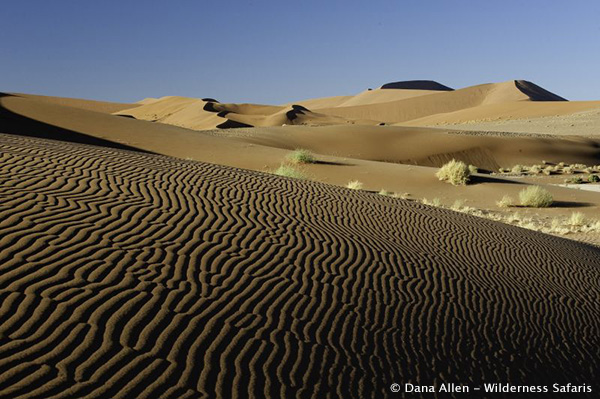
Day 3: Sossusvlei to Swakopmund
NOTE: Option to include a sunrise balloon flight or scenic light aircraft flight over the Namib Naukluft National Park before you depart for Swakopmund (optional extra at additional cost). Please note that if making use of this offer, it will need to be pre-booked in order to fit in with other timings for this day.
The fascinating drive today takes you northwest through awesome and ever changing desert landscapes of the Namib Naukluft National Park, including the impressive Gaub and Kuiseb canyons. You will meet the coast at the port town of Walvis Bay and then continue north to Swakopmund where you can enjoy the pleasant seaside location and cooler coastal air for your next two nights. There will be time this afternoon to explore the town and wander along the waterfront on foot, before heading off for dinner at a popular restaurant which specializes in fresh seafood.
NOTE: As an alternative to the drive from Sossus Dune Lodge to Swakopmund you may like to take a scenic light aircraft flight over Sossusvlei and along the Diamond Coast (optional extra at additional cost), allowing you a bird’s eye view over the dune sea, abandoned mining camps, shipwrecks, Sandwich Harbour and salt pans before you land at Swakopmund Airport. Your guide will drive to meet up with you in Swakopmund later in the day. Please note that if making use of this offer, flights will need to be booked with us for absolute logistical reasons.
Swakopmund: Swakopmund resembles a small, German coastal resort nestled between the desert and the sea. It boasts a charming combination of German colonial architecture blended with modern hotels, shops, restaurants, museums, craft centres, galleries and cafés. Swakopmund had its beginnings as a landing station in 1892 when the German Imperial Navy erected beacons on the site. Settlers followed and made attempts to create a harbour town by constructing a concrete Mole and then an iron jetty - which attempts were ultimately unsuccessful. The advent of World War one halted developments, and the town sank into decline until half a century later when infrastructure improved and an asphalt road opened between Windhoek and Swakopmund. This made reaching the previously isolated town quicker and easier and it prospered once again to become Namibia’s premier resort town. Although the sea is normally cold for swimming there are pleasant beaches and the cooler climate is refreshing after time spent in the desert.
Centrally located guesthouse: A guesthouse located centrally in Swakopmund will be used for the next two nights in the town.
Overnight: Centrally located guesthouse
Breakfast, Lunch & Dinner
Day 4: Swakopmund
After an early breakfast your guide will drive you along the scenic coastal road back south to Walvis Bay for a memorable kayaking adventure within the outer lagoon. After meeting your kayaking guide you will be taken on a short scenic drive to Pelican Point to see its lighthouse and windswept beauty, stopping briefly at the salt works to view the variety of birdlife on your way to the launch point. The kayaking is an ideal way of seeing Cape fur seals, Heaviside and bottlenose dolphins, pelicans, flamingos and a wide variety of other sea birds. If you are lucky, there is also a chance of seeing whales, leatherback turtles and sunfish. During the course of the day the guide will stop and inform you about the environment and light refreshments will be served on the beach before heading back to Walvis Bay.
You also have the choice to partake in a memorable motorized boat seal and dolphin excursion within the outer lagoon and harbour should the kayaking not appeal. Here you should also see Cape fur seals, heaviside and bottlenose dolphins, pelicans, flamingos and a wide variety of other sea birds. Again, if luck is on your side, there is also a chance of seeing whales, leatherback turtles and sunfish. During the course of the excursion snacks will be served along with local sparkling wine and fresh oysters, before you will return to the jetty at roughly midday.
You then have the opportunity to explore the waterfront area of Walvis Bay further before returning to Swakopmund for an afternoon at leisure at your guesthouse or out in town. Activities such as camel rides, scenic flights, quad-biking in the coastal dunes, tandem or solo sky diving and more can all be booked at an extra cost.
Overnight: Centrally located guesthouse
Breakfast, Lunch, Dinner & Marine Excursion
Day 5: Swakopmund to Damaraland
Continuing on your safari today, the road takes you north and east into the wonderful and diverse region of Damaraland. You pass Namibia’s highest mountain, the Brandberg which peaks at 2,573 m above sea level, and take time to view game and absorb the vastness of the scenery along the way. Damaraland is typified by displays of colour, magnificent table topped mountains, rock formations and bizarre-looking vegetation. The present day landscape has been formed by the erosion of wind, water and geological forces which have formed rolling hills, dunes, gravel plains and ancient river terraces. It is the variety and loneliness of the area as well as the scenic splendour which will reward and astound you, giving one an authentic understanding of the word 'wilderness'.
If time allows this afternoon your guide will take you to visit the nearby attractions and geological sites of the pre-historic Twyfelfontein rock engravings (recently declared a UNESCO World Heritage Site), Burnt Mountain and the Organ Pipes - if not there is plenty of time to see them tomorrow.
Twyfelfontein: Strewn over a hillside amongst flat-topped mountains of red sandstone, Twyfelfontein’s boulders and slabs of red sandstone hold some 2,500 prehistoric engravings that depict wildlife, animal spoor and abstract motifs. It is perhaps the largest and finest collection of petroglyphs in Africa. The engravings show animals such as elephant, giraffe, kudu, lion, rhinoceros, springbok, zebra and ostrich that once used to drink from a fountain at the bottom of the hill. In some cases footprints were engraved instead of hooves or paws. The abstract motifs feature mainly circles. Stone tools and other artifacts found at Twyfelfontein suggest that hunter-gatherers occupied the site over a period of perhaps 7,000 years. These days a local guide accompanies visitors to showcase the rock art. The engravings lie along two circular routes, one an hour’s climb and the other 40 minutes longer. Twyfelfontein is one of Namibia’s key National Monuments and has recently become a UNESCO World Heritage Site.
Burnt Mountain: A rounded hill located a few kilometers from Twyfelfontein and the Organ Pipes, known as the Burnt Mountain, seems to catch fire again at sunrise and sunset. Its fantastic range of colours at dawn and dusk are due to a chemical reaction that took place roughly 125 million years ago when molten lava penetrated organic shale and limestone deposits, resulting in contact metamorphism. In ordinary sunlight it is a dull black. Blackened rubble lies to one side like cinders from the original fire.
Organ Pipes: The Organ Pipes are another geological curiosity in the area consisting of a mass of perpendicular dolerite columns that intruded the surrounding rocks also about 125 million years ago and have since been exposed in a ravine due to river erosion.
Overnight: Camp Kipwe
Breakfast, Lunch, Dinner & Excursions with Guide
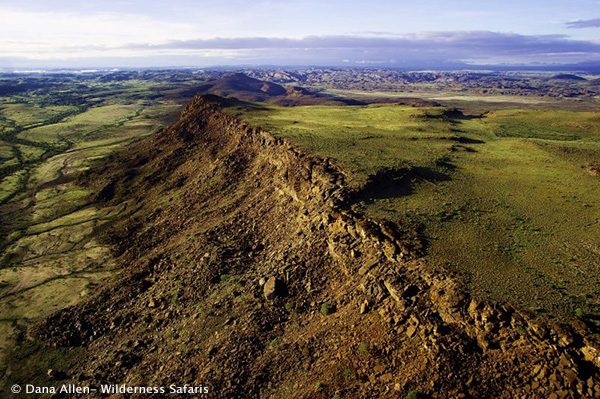
Day 6: Damaraland
After an early breakfast you will be treated to an exciting 4x4 excursion along the ephemeral Aba Huab and Huab River valleys to explore this remarkable region and to search for game, including the elusive desert adapted elephants if they are in the area. Damaraland is home to a variety of desert adapted wildlife and hidden desert treasures. As the elephants are mostly active in the mornings you will normally have the best chance to see them then before returning to camp for lunch. However, if all the safari participants agree, you also have the option to take a picnic lunch and stop to enjoy that in the shade of a large Ana tree by the riverbed, ideally while watching a herd of elephant browsing nearby.
Your guide will arrange to fit in a visit to Twyfelfontein and other nearby attractions at a suitable time if you haven’t already done so the previous day. On return to camp there should be time to take a walk into the local area with your guide if desired, or simply relax and enjoy some well-deserved leisure time.
Desert Adapted Elephant: In habitats with sufficient vegetation and water an adult elephant consumes as much as 300 kg of roughage and 230 litres of water every day of its life. Consider what a herd of them would eat and drink in a week or a month or a year. Finding an African elephant in a desert? Well, yes and not only elephant, but other large mammals as well, such as black rhinoceros and giraffe. Their ranges extend from river catchments in northern Kaokoveld as far south as the northern Namib. Apart from the Kunene River, seven river courses northwards from the Ugab provide them with possible routes across the desert, right to the Skeleton Coast. The biggest are the Hoarusib, the Hoanib, the Huab and the Ugab Rivers. Desert adapted elephant in Kaokoland and the Namib walk further for water and fodder than any other elephant in Africa. The distances between waterholes and feeding grounds can be as great as 68 km. The typical home range of a family herd is larger than 2,000 km², or eight times as big as ranges in central Africa where rainfall is much higher. They walk and feed at night and rest during the day. To meet their nutritional and bulk requirements they browse on no fewer than 74 of the 103 plant species that grow in their range. Not a separate species or even a subspecies, they are an ecotype unique to Namibia in Africa south of the equator, behaviourally adapted to hyper-arid conditions. Elephant in Mali on the southwestern fringe of the Sahara Desert are the only others known to survive in similar conditions.
Overnight: Camp Kipwe
Breakfast, Lunch, Dinner & Excursions with Guide
Day 7: Damaraland to Southern Etosha National Park
Today after a very early breakfast you set off on your journey to the Etosha National Park, travelling via the scenic Grootberg Pass. Along the way your guide will take you to visit a local Himba settlement – you may have to search for a while as the semi-nomadic Himba people sometimes move location with no notice. They are one of the last truly traditional peoples of Namibia and have little time for conventional practices. Here you will learn about the customs and traditions of this very proud nation, and will be given insight into their beliefs, way of life and everyday routine. You will also visit the Grootberg Primary School, a rural school where Ultimate Safaris’ Conservation Travel Foundation is actively involved, assisting with improved education infrastructure and methods. After visiting the Himba and school you will head east through the small town of Kamanjab before heading on towards tonight’s destination at the homey Andersson’s Camp, which is situated just south of the Etosha National Park’s Andersson Gate. A picnic lunch will be enjoyed en-route and arrival will be in the very late afternoon or early evening (after a long but rewarding day). After your arrival you will have some time at leisure, which can be spent appreciating the unique surroundings and enjoying the game viewing at the camp’s floodlit waterhole.
The Himba: The Himba, Tjimba and other Herero people who inhabit Namibia’s remote north-western Kunene Region are loosely referred to as the Kaokovelders. Basically Herero in terms of origin, language and culture, they are semi-nomadic pastoralists who tend to tend from one watering place to another. They seldom leave their home areas and maintain, even in their own, on which other cultures have made little impression. For many centuries they have lived a relatively isolated existence and were not involved to any noteworthy extent in the long struggle for pasturelands between the Nama and the Herero. The largest group of Kaokovelders is the Himba, semi-nomads who live in scattered settlements throughout the Kunene Region. They are a tall, slender and statuesque people, characterized especially by their proud yet friendly bearing. The women especially are noted for their unusual sculptural beauty, enhanced by intricate hairstyles and traditional adornments. They rub their bodies with red ochre and fat, a treatment that protects their skins against the harsh desert climate.
The homes of the Himba of Kaokoland are simple, cone-shaped structures of saplings, bound together with palm leaves and plastered with mud and dung. The men build the structures, while the women mix the clay and do the plastering. A fire burns in the headman’s hut day and night, to keep away insects and provide light and heating. A family may move from one home to another several times a year to seek grazing for their goats and cattle. A Himba woman spends as much as three hours a day on her toilette. First she bathes, then she anoints herself with her own individually prepared mixture which not only protects her skin from the harsh desert sun, but also keeps insects away and prevents her body hair from falling out. She uses another mixture of butter fat, fresh herbs and black coals to rub on her hair, and ‘steams’ her clothes regularly over the permanent fire. Men, women and children adorn themselves with necklaces, bracelets, anklets and belts made from iron and shell beads. With their unusual and striking designs, these items have gained a commercial value and are being produced on a small scale for the urban market. Sculptural headrests in particular are sought-after items.
Overnight: Andersson’s Camp (Wilderness Safaris' camp)
Breakfast, Lunch, Dinner & Excursions with Guide

Day 8: Southern to Eastern Etosha National Park
Today is dedicated to a full day of exciting game viewing within the central section of Etosha National Park from your private safari vehicle as you make your way from the southern Andersson’s Gate to Halali (where you may stop for lunch) and then on across via selected waterholes such as Goas, which are normally particularly good for game viewing, to Namutoni Camp in the east. You will have to leave the Park before sunset and head out to stay at the delightful Onguma Tree Top Camp with enough time to relax and freshen up before for dinner. The rest of the evening can be spent game viewing at the camp’s floodlit waterhole where game comes and goes throughout the day and night.
Etosha National Park: Etosha National Park covers 22,270 km²², of which approximately 5,000 km² is made up of saline depressions or ‘pans’. The largest of these pans, the Etosha Pan, can be classified as a saline desert in its own right. The Etosha Pan lies in the Owambo Basin, on the north-western edge of the Namibian Kalahari Desert. Until three million years ago it formed part of huge, shallow lake that was reduced to a complex of salt pans when the major river that fed it, the Kunene, changed course and began to flow to the Atlantic instead. If the lake existed today, it would be the third largest in the world. Etosha is the largest of the pans at 4,760 km² in extent. It is nowadays filled with water only when sufficient rain falls to the north in Angola, inducing floods to flow southward along the Cuvelai drainage system. The Park consists of grassland, woodland and savannah. Game-viewing centers around the numerous springs and waterholes where several different species can often be seen at one time. The Park boasts some 114 mammal and over 340 bird species. Wildlife that one might see includes elephant, lion, giraffe, blue wildebeest, eland, kudu, gemsbok (oryx), zebra, rhino, cheetah, leopard, hyena, honey badger and warthog, as well as the endemic black faced impala.
Overnight: Onguma Tree Top Camp
Breakfast, Lunch, Dinner & Etosha Game Drives with Guide
Day 9: Etosha National Park / Onguma Game Reserve
Another morning dedicated to memorable game drives within the eastern section of Etosha National Park with your guide. You return to camp for lunch and an early afternoon rest, spending your final afternoon on a game drive on the private Onguma Game Reserve, culminating in a sundowner overlooking Fischer’s Pan. You then return after sunset with enough time to freshen up and enjoy your final ‘safari dinner’ overlooking the camp’s floodlit waterhole.
Onguma Game Reserve: Situated on the eastern side of Etosha National Park and bordering Fisher’s Pan, Onguma Game Reserve has more than 20,000 hectare of protected land and wildlife. The nature reserve boasts over thirty different animal species consisting of plains game such as kudu, giraffe, eland, oryx, hartebeest, zebra, impala and many more roam freely, as well as predators such as lion, cheetah and leopard, being common residents of the area. Onguma Game Reserve is now proud to be home to a family of black rhinos! More than 300 bird species can also be viewed at Onguma Game Reserve.
Overnight: Onguma Tree Top Camp
Breakfast, Lunch, Dinner, AM Etosha & PM Onguma Drives
Day 10: Onguma Game Reserve to Windhoek via the AfriCat Foundation
Your early departure will take you south from Onguma Tree Top via Tsumeb, Otavi and Otjiwarongo to reach Okonjima’s AfriCat Day Centre, a wonderful highlight with which to conclude your safari. Okonjima is home to the AfriCat Foundation, a wildlife sanctuary which focuses on the research and rehabilitation of Africa's big cats, especially injured or captured leopard and cheetah. You arrive in time for lunch before embarking on an exciting and informative game drive and tour of the centre. Here you will learn about the function and vision of the AfriCat Foundation and will also get to meet some of the Foundation’s special carnivore ambassadors. After the excursion and freshening up, the journey continues further south to arrive back in Windhoek in the late afternoon, just as the sun is setting. Upon your arrival in Windhoek you will be transferred to your accommodation establishment of choice, or out to the Windhoek International Airport (transfer to be booked additionally) if flying out in the evening - departure flights must be no earlier than 21h00 to allow sufficient time for the visit to the AfriCat Foundation and the journey back to Windhoek, or a final night in Windhoek can be arranged at additional cost if required. A final night in Windhoek is highly recommended!
NOTE (OPTIONAL EXTENSION):
You have the option to extend your safari for an additional night or two at Okonjima, staying at their delightful Luxury Bush Camp. This affords you the opportunity to get a more in-depth insight into the work being done by the AfriCat Foundation as well as getting to see more of cheetah, leopard and other big cats in the wild. Ask for pricing.
Breakfast & Lunch
Day 1 & 2: Sossus Dune Lodge, |
 |
Day 3 & 4: A centrally located guesthouse, |
|
Day 5 & 6: Camp Kipwe, |
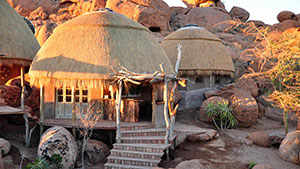 |
Day 7: Andersson’s Camp, |
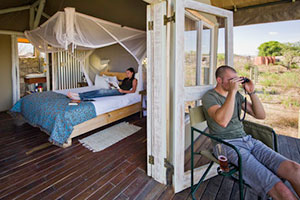 |
Day 8 & 9: Onguma Tree Top Camp, |
 |




